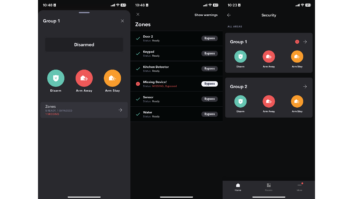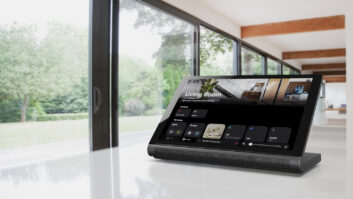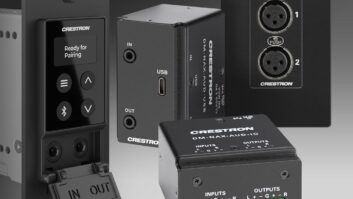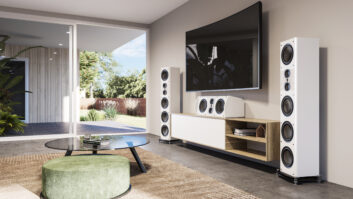
“If someone were to blindfold you and take you into this space, you’d have no idea you were underground,” said Brian Thompson, system design engineer for Logic Integration of Lone Tree, CO, talking about an underground condominium project he worked on this year, carved out of a decommissioned nuclear missile silo in rural Kansas.
“The developer has spent a significant amount of time making it comfortable, and it feels very much like a five star resort.”
“It’s a real community,” said Tommy Nix, lead installer and project manager. In addition to nine residential units and four guest suites, there’s a school, a library, a theater, a general store, a first-aid center with a pharmacy, a fitness center and a swimming pool. Three sources of electric power, a hydroponics farm, a renewable water supply and an elaborate security system make this underground village entirely self-sufficient, able to support its residents indefinitely should the need arise.
The idea of a survival bunker has adherents and detractors. “We believe that given the present worldwide conditions, it is prudent to have a ‘disaster plan and shelter’ in place should a need for it arise,” said developer Larry Hall, who believes in the concept enough to include a home for his own family, as well as for clients. “Of course a nuclear hardened facility like what we have here pretty much covers most concerns.”
The biggest problem, according to Hall, is not mere survival, but the ability and desire to keep going in the event of a worldwide catastrophe. “The trick is normalcy—to make things as normal as you can for as long as you can,” he explained. Thus Hall’s facility looks more like a condominium development than a bunker, although it does have some unique features.
The AV and control systems, based largely on Crestron control and Crestron DigitalMedia technology, go a long way in making all of this possible, the company reports.
One detail that makes a huge contribution to the sense of normalcy experienced by residents is a series of virtual windows that Bill Craig, Logic’s vice president of business development, included in the technology concepts he created for the project. “Every unit is equipped with them,” Nix explained. “Given how well they work, they are one of my favorite features in a project that’s full of very cool technology.”
The window itself is a 55-inch LED monitor, mounted vertically and encased with moldings and a sill just like a real window. Each unit has at least four, placed in different rooms and looking out in different directions. On a 60-foot utility tower built above the complex are a number of high-definition cameras, each positioned so the direction of its view is exactly the same as the corresponding windows in the complex below. “Look out a north-facing virtual window and you’re actually looking to the north across the property,” Nix explained. “The feeds are live, and you get a true sense of direction, time and place.” If a deer, for example, walks across the north end of the property going east, you can walk over to your east window and see him come into your view just as you would with a set of real windows.

Windows, of course, provide not only an outside view but bring light into a room. “We programmed the lighting control system to simulate window light,” Thompson added. For example, you can get up early and watch the dawn, and as the sun comes up the room light intensifies, especially on the wall opposite the window. “If you want to, you can wake up with the sunrise, just by leaving your virtual window on overnight,” Nix explained. “It’s not the same intensity as sunlight, but it gives you the same feeling and takes away the sense of being closed in.”
The spaces inside the bunker are not huge—four residences are 1,800 square feet and six more are 900 square feet—but they feel open and roomy. The condos are luxurious, with Sub-Zero appliances and Wolf ranges.
The media systems are luxurious as well. Each residence is equipped with a Crestron MC3 3-Series control processor, wall-mounted Samsung LED televisions, Crestron four-room audio processors, and Crestron ceiling and wall-mount speakers. Sources include Kaleidescape media servers, DirecTV receivers, Sonos music streaming systems, Crestron docking stations for the iPod, Apple TV’s, and Internet radio.
The entire facility is wired using Crestron DigitalMedia technology, which delivers the current 1080p high-definition standard without compression. The system will be ready for 4K ultra-high-definition when that standard is more widely available.
Logic Integration installed almost 70 Crestron touch screens throughout the facility, including one or more 7-inch plus two or more handheld Crestron remotes in each residence. In addition, residents can load the Crestron app on their Apple or Android phones and tablets, giving them wireless control of media, lighting and access to some of the unique security features of the complex.
Security, of course, is what this complex is all about. With a core that was built in the 1960s to withstand anything, including a direct nuclear hit, the facility is ready for tornados, floods, earthquakes, and any type of energy, food, water, economic or political crisis.
Neither the developer nor the integrator will provide details of the security system—or, in fact, even the exact location of the complex—but there are one or two interesting features they will talk about.
One is an alert system programmed into the Crestron system, which sends status notifications and alerts to the Crestron touch screens, tablets, and common area TV displays. Homeowners can view details of a yellow or red alert—and they can press an alert button should they need help for any reason.
The other is an elaborate video surveillance system which allows a full-time security staff, as well as residents to view exactly what’s going on outdoors on the property, plus inside in the common areas. They can view the video at any time, whether they are in their condos or hundreds of miles away.
One of Hall’s goals, related to the sense of normalcy, is to foster a sense of community. “Our homeowners are not stereotypical ‘survival nuts’ as portrayed in movies, but individuals with the desire to provide care and protection for their family,” he explained. Buyers range from medical professionals to mechanics to military servicemen. Nearly all of them have children.
The common areas help build that sense of community by encouraging homeowners and their children to interact with each other and build friendships.

The classroom is intended both for independent online learning and traditional teacher-led classes. There are nine cubical workstations arranged along a circular half wall plus a teacher station with a 70-inch Sharp interactive display opposite. If students turn their chairs around, they can see the instructor and each other clearly, yet they have easy access to the computers.
The swimming pool enclosure includes a climbing wall and a jungle mural, giving it an open, kid-friendly feel.
“The theater is unbelievable,” said Nix. “We fit 17 CinemaTech recliners into a relatively small space, but they work well. We have acoustical treatments, an energy-efficiency Digital Projection LED projector, Crestron audio, and a DM16X16 switcher. The sound and video are incredible.”
Although Hall spent six years planning and building the facility, the AV portion of the project took just nine months from concept to completion. “On the one hand, that’s a very short time to conceive and build systems this innovative,” Thompson said, “but in practical terms, it’s a lot longer than we normally would have for a project of this size.”
One key to the team’s ability to design complex systems in short timeframes is their standardization on a few main vendors including Crestron. “Yes, there was a lot of very custom programming here, but we know the Crestron systems inside and out. Once we had worked out what the systems should do, making them do it was relatively simple.”
The project has been extremely well received by potential buyers, with the first facility completely sold out before it was finished. Hall and his team have started construction on a new set of residences in a second decommissioned silo.
“From an engineer’s perspective, it’s a dream come true,” Nix said. “We are using the very latest and very best Crestron gear, so new that, for some of it, we’re helping them finalize the firmware.”
“To be able to work on a project of this caliber, with the team we have at Logic and with Larry Hall and his people was a terrific experience. If you’re passionate about technology, you are instantly in love with this project.”







